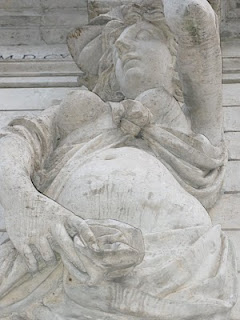Having declared the first modern building in Rome's center in nearly a century an official eyesore on the sights of stunning Rome, wanting to dismantle it, and in the best case, rebuild it in Rome’s ugly suburbs (so much for beautifying the entire city - in his eyes), I thought he descended upon the Altar to declare instead its official Dignity; to Pardon Meier for his horrific creation, and to start forward toward modernizing Rome in an act of Reconciliation. This single act would lead the way toward building something new again within the city center limits.
Turns out I was wrong. On all accounts. While the city keeps up its campaign of eye pollution in allowing the hundreds of illegal advertising billboards, while it allows the SS teams in the Parks&Gardens Office to continue razing any sign of greenery in the city (leaving behind a trail of meter-high grey tree stumps which get uprooted only for planting a billboard), this was a matter of a totally different sort.
Although it must have pained Alemanno to hold his celebration at his most hated monument, he even stood to accept a sheet of pergamon to convey the lofty ideals of respect, comprehension and dialogue. Three characteristics that do not surround his Meier diatribe (built by the former left-wing Mayor). In his words,
“Occorre saper comprendere le vere ragioni dei conflitti. Al tempo stesso, "non bisogna chiudersi nella vendetta e nell'odio ma affrontare le cause reali.”
“One needs to search out the real reasons for conflict.” At the same time, “One shouldn’t close himself behind hate and revenge but take on the true causes.”
Now if he would practice what he preaches, maybe the fatwa against Meier can be lifted, and the Mayor can preside over a Pax Alemanno of sorts.
picture courtesy of bluffton.edu
click here to see the entire Altar & museum in its splendor
From RomanGuide: After a century of bloody civil and foreign wars that had brought to the end of the Roman Republic, Augustus, who had ruled as emperor since 27 B.C., seemed finally to have placed the Romans under his own personal peace, the Pax Augusta. In recognition of this achievement, the Roman Senate voted in 13 B.C. an altar dedicated to peace and to the emperor who had made the end of the civil wars possible. The result, completed about four years later, was a triumph. The Ara Pacis Augustae, the Altar of Augustan Peace is the most intimate imperial monument. The Ara (a 35x39 foot rectangle), is a perfect example of the elegant and gracious style cultivated by Augustus. Justly proud of his altar, Augustus made mention of the circumstances that led to its creation in his Achievements of the Divine Augustus (Res Gestae divi Augusti), the official autobiography written near the end of his long reign.








